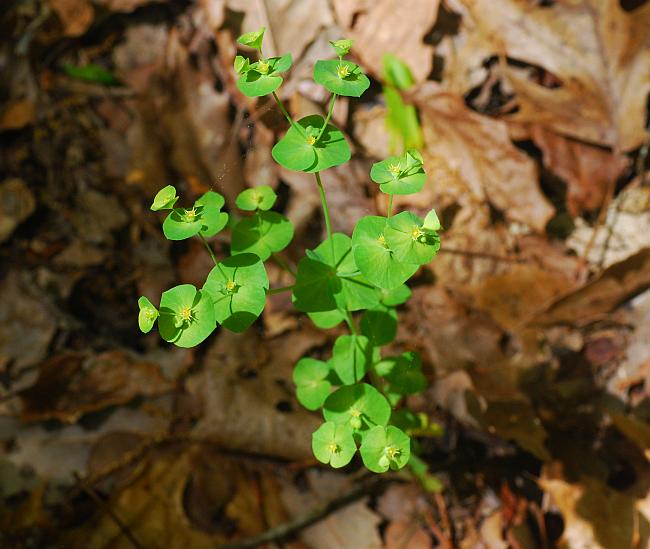Euphorbia commutata Engelm.
Wood Spurge

Native
CC = 6
CW = 3
MOC = 29
© SRTurner
Euphorbia commutata Engelm.Wood Spurge | |
 |
Native CC = 6 CW = 3 MOC = 29 |
© SRTurner |
|
Family - Euphorbiaceae Habit - Fibrous-rooted perennial forb. Stem - Ascending from a frequently spreading base, to 50 cm, often branched from near the base, otherwise often unbranched below the inflorescence, green to yellowish green, sometimes strongly reddish-or purplish-tinged toward the base, glabrous.
Leaves - Alternate above the lowermost node and below the inflorescence branches, sessile or rarely minutely petiolate, those of the overwintering shoots mostly short-petiolate. Leaf blades 5-30 mm long, unlobed, the margins entire, the surfaces glabrous, those below the inflorescence oblanceolate to obovate, tapered at the base, rounded or abruptly short-tapered to a minute, sharply pointed tip; those along the inflorescence branches kidney-shaped to broadly ovate, the bases broadly rounded to cordate and clasping the stem or occasionally perfoliate, the terminal ones somewhat cupped around the cyathia, rounded or very broadly angled to a bluntly pointed tip.
Inflorescences - Terminal, often umbellate panicles with opposite or whorled leaves at the base and each of the primary branches usually branched 1-3 additional times, the cyathia solitary at the branch points and solitary or more commonly in small clusters at the branch tips.
Cyathia - Involucre 1.7-2.5 mm long, glabrous, the rim shallowly 4-lobed, the margin usually minutely and inconspicuously hairy, the marginal glands 4, 0.8-1.3 mm long, crescent shaped, the oblong body tapered into a pair of slender, spreading horns, yellow, lacking petaloid appendages. Staminate flowers 9-15 per cyathium. Ovaries glabrous, the styles 0.9-1.3 mm long, each divided 1/2-2/3 of the way from the tip into 2 relatively slender lobes.
Fruit - 2.7-3.5 mm long, glabrous, smooth. Seeds 1.5-2.0 mm long, broadly oblong-elliptic to broadly ovate or nearly circular in outline, nearly circular in cross-section, rounded or slightly angled at the base, the surface strongly pitted, dull gray to olive gray, with a pale, irregularly winglike caruncle (shaped similar to a tiny fortune cookie).
Flowering - April - June. Habitat - Forests, bluffs, streambanks, edges of glades. Origin - Native to the U.S. Lookalikes - E. obtusata. Other info. - This distinctive and somewhat peculiar looking plant is found in the southeastern half of Missouri, extending down into Arkansas and eastern Oklahoma. This particular distribution is somwhat disjunct from other occurrrences of the plant in the continental U.S., which are scattered throughout the eastern third of the country. Photographs taken at Valley View Glade Natural Area, Jefferson County, MO, 4-28-2010, Washington State Park, Washington County, MO, 5-3-2014, Young Conservation Area, Jefferson County, MO, 5-17-2019, and Glassberg Conservation Area, Jefferson County, MO, 4-30-2020 (SRTurner). |